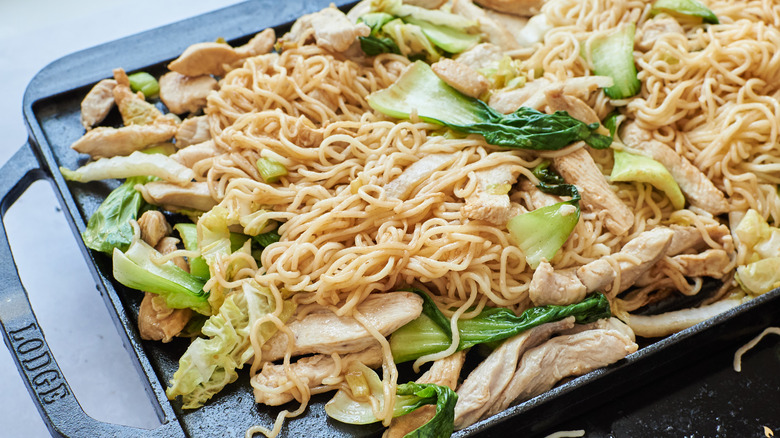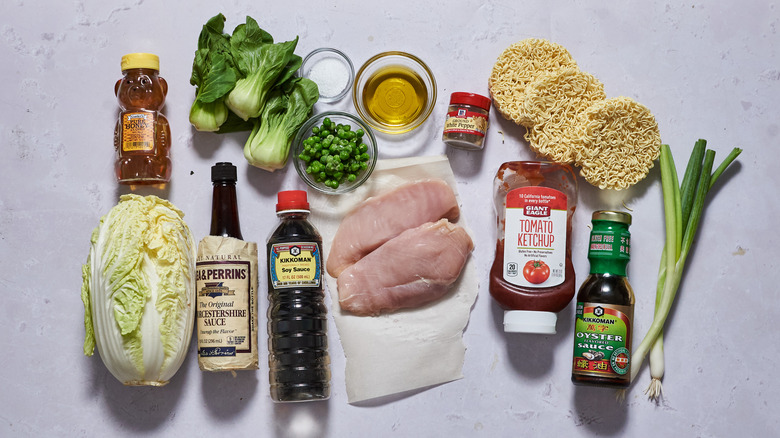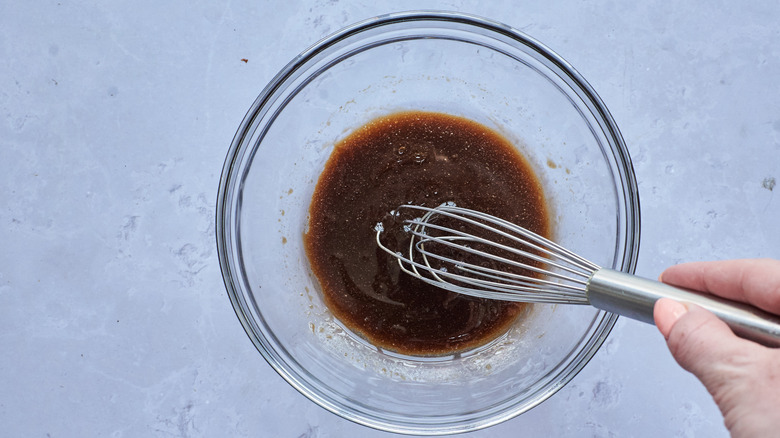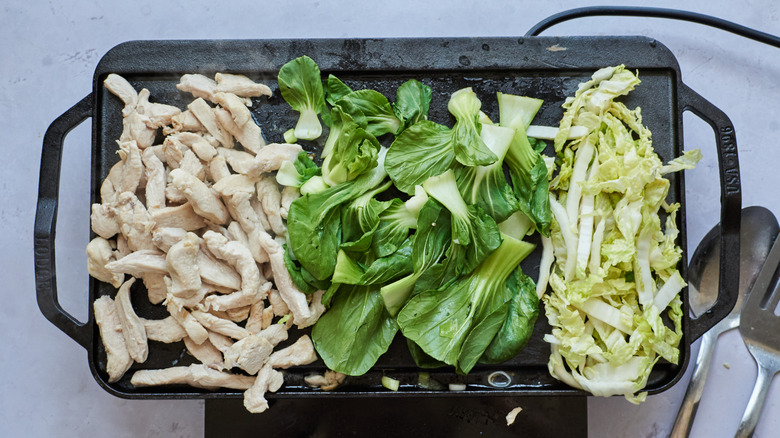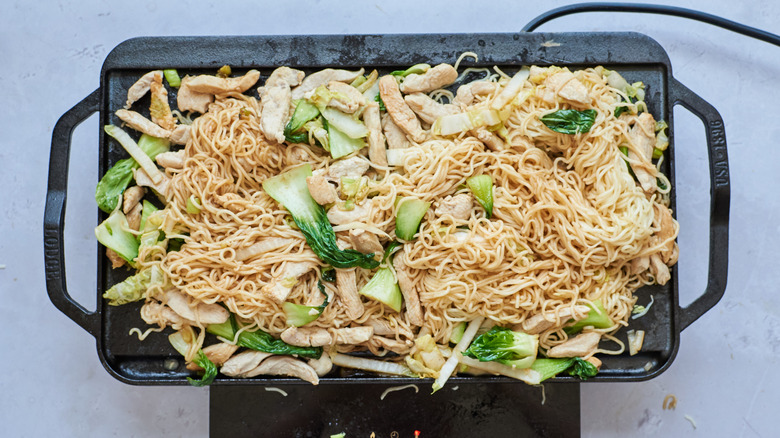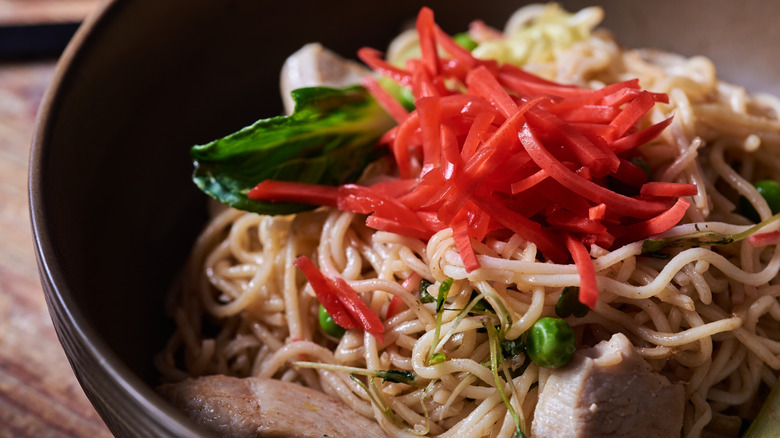At-Home Chicken Yakisoba Recipe
When thinking of Japanese food, it's easy to automatically think of sushi and ramen. One of Japan's most famous dishes, though, is a stir fry called yakisoba, and like many of the world's most loved dishes it originated out of necessity after World War II, when flour was expensive in Japan and cabbage was used to stretch the volume of wheat noodle dishes. Because the cabbage's flavor became diluted with water, Worcestershire sauce become a go-to seasoning sauce, providing savory depth in the cabbage.
Despite what the name implies, yakisoba is made with Chinese-based wheat noodles, not the brown buckwheat noodles used in soba noodle dishes. The noodles are stir-fried on large griddles called teppans. Stir-frying the noodles on this grill makes yakisoba ideal for outdoor markets, where it truly became an iconic street food.
According to recipe developer Michelle McGlinn, the tangy sauce is possibly the most unique part of yakisoba and differs greatly between Japanese regions. This recipe keeps things mostly classic with a Worcestershire-based sauce that also features soy sauce, honey, and oyster sauce. This recipe also utilizes ketchup for a hint of tang that caramelizes on the hot griddle and browns the crispy noodles. If you don't love ketchup, you can always omit it for a traditional yakisoba.
Gather the ingredients for at-home chicken yakisoba
The sauce will add a lot of salty flavor to the dish, so you will just need chicken and salt to begin. We like thin strips of chicken breast, but you can also use sliced chicken thighs or tenderloins. The only vegetable necessary for yakisoba is cabbage — from there, you can load up the noodles with veggies or keep it simple. For our recipe, we use scallions, Napa cabbage, bok choy, and peas. Speaking of the noodles, you'll need a few pucks of classic ramen noodles for this recipe.
For the sauce, you will need Worcestershire sauce, honey, soy sauce, oyster sauce, and white pepper. You can swap the honey for white sugar if needed, and optionally, you can add ketchup for added sweetness and tang. If you can't have fish, omit the oyster sauce and use vegan Worcestershire. For toppings, try the traditional pickled ginger and add a leafy green like scallions or microgreens to brighten the dish.
Prep the sauce
Whisk together the sauce ingredients in a small bowl. The sauce will be very tangy on its own, but the flavor deepens when cooked, and the acidic flavor gets diluted by the cabbage (remember, that's why Worcestershire is used). If using ketchup, start with a small amount (just one teaspoon) so as not to overpower the already tangy sauce. If you like your yakisoba more wet, double the sauce recipe.
Cook the chicken and vegetables
Yakisoba is made in parts, moving the elements around the griddle to cook everything evenly. Because the chicken takes the longest, season and add it to the griddle first, browning it deeply on all sides. Once browned, move the chicken to the side of the griddle, away from the direct heat. Add the scallion and cabbage (or any hardy vegetables like peppers) and cook until just softened. Move these to the side of the griddle, away from direct heat. Add the bok choy and cook until browning on the edges; the leafy parts will be soft and bright green.
Add the noodles and sauce
If needed, add oil to the griddle, then add the noodles and fry until starting to brown on the edges. Toss constantly to avoid sticking. Once starting to crisp, toss the noodles with the chicken and veggies, combining the yakisoba into a big stir fry. Toss in the sauce, coating all the noodles and chicken. Cook the stir fry until the sauce starts to caramelize, then remove the griddle from the heat.
Serve the chicken yakisoba with garnishes
Yakisoba is traditionally served with pickled ginger, which adds a sweet-and-sour flavor to the salty noodles. McGlinn also likes to add leafy greens for a fresh crunch, and recommends using microgreens, scallions, or even cilantro. You can also top with sesame seeds, green nori, or even mayonnaise.
For pairing options, try serving yakisoba with Japanese side dishes such as gyoza, onigiri, and cucumber salad. Yakisoba saves well (just like your favorite takeout) and can be microwaved easily the next day — or the next few days, making it ideal for meal prep.
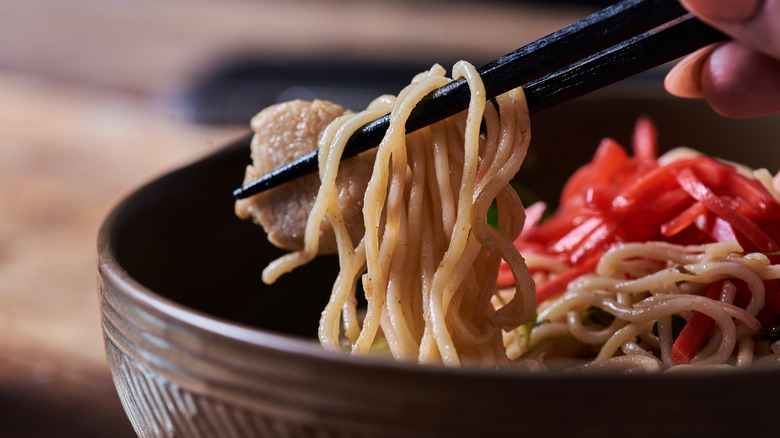
- 2 tablespoons Worcestershire sauce
- ½ tablespoon honey
- 1 tablespoon soy sauce
- 1 tablespoon oyster sauce
- ¼ teaspoon white pepper
- 8 ounces ramen noodles, cooked
- 3 tablespoons neutral oil, divided
- 1 pound chicken breasts, sliced into strips
- 1 tablespoon salt
- 2 scallions, finely chopped
- 1 cup chopped Napa cabbage
- 3 baby bok choy, leaves separated
- ½ cup frozen peas, thawed
- 1 teaspoon ketchup
- Pickled ginger, for serving
- Microgreens, for serving
- To prepare the sauce, whisk together the Worcestershire, honey, soy sauce, oyster sauce, white pepper, and ketchup, if using, in a small bowl. Set aside.
- Once the noodles are cooked and drained, toss with 1 tablespoon of neutral oil and set aside.
- Sprinkle salt over chicken. Heat an oiled griddle or large cast-iron skillet over medium heat.
- Once hot, add the chicken and cook until browned. Move to the side of the griddle.
- Add the scallion and cabbage and cook until beginning to soften. Move to the side of the griddle.
- Add the bok choy and cook, stirring constantly, until wilted and beginning to char. Combine the vegetables and chicken together and push to the side of the skillet. Add more oil as needed.
- Add the noodles to the griddle and stir constantly, softening the noodles. As they begin to brown, add the sauce. Toss the sauce into the noodles, then combine with the vegetables and chicken. Toss together, heating until noodles start to become crispy.
- Add the peas last, tossing to warm through.
- To serve, divide into bowls and top with microgreens and pickled ginger.
